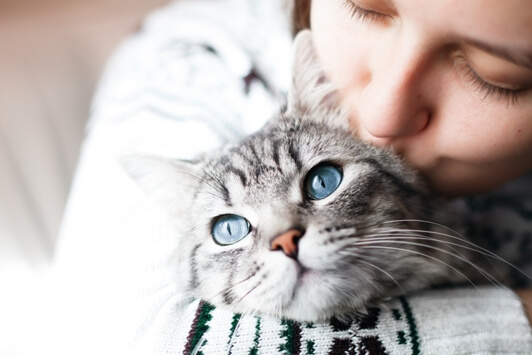
Cats are wonderful, mysterious creatures. And that's just two of the many reasons we love having them as a part of our family! On the other hand, cats are notorious for masking symptoms of disease, which can make determining their health needs increasingly challenging as they age. The signs are there, however, if we know what to look for. In what follows, we'll review the signs and reveal several things pet parents can do to optimize their cats' nutrition as they age.
When are Cats Considered Senior?
Generally speaking, cats can be considered senior if they're somewhere between 7-10 years of age. There is not one specific age, largely due to differences in quality of nutrition and the varying health states of individual cats. Unlike dogs, which have a wide variation in aging due to size differences between breeds, cat breeds all age at about the same rate.
Common signs of aging in cats include decreased jumping due to arthritis, weight changes (either gain or loss), changes in sleeping patterns, changes in drinking and/or urinating behavior, and cognitive changes such as seeming disoriented or lost. Although these symptoms are associated with age, they also reflect disease processes. If your cat exhibits any of the above symptoms, visit your veterinarian to make sure that you're not dealing with a dire medical condition that might require immediate treatment! Better safe than sorry.
Dogs vs Cats - More Differences
While older dogs have decreased energy needs, the same is not true for cats. The caloric needs of cats decrease until age 11, then start to increase again (which is why you see many obese 9 year olds but very few obese 16 year old cats). Cats are obligate carnivores so their nutritional needs are very different from omnivores such as dogs and people.
Protein & Fats
Senior cats may not digest protein and fat as efficiently as they age. Thus, the takeaway here is that not only the quantity, but the quality of protein and fats, matters. If protein intake remains too low, your cat may experience impaired immune function and muscle wasting. Digestibility is the key obtaining nutrients from foods, so it’s best to feed high-quality protein sources that are easily absorbed by a gut that may not be performing at optimal levels.

Four Age-Associated Diseases You Need to Know
Diabetes is usually associated with obesity. High-protein, lower-carbohydrate diets can help blood sugar stabilize and reduce the need for insulin. Weight loss greatly improves the condition. Signs of diabetes include increased drinking and urination, sudden weight loss. Note that these symptoms are very similar to those of hyperthyroidism, another common disease in older cats.
Dental disease can make it harder for cats to crunch on kibble, leading to weight loss secondary to pain. Soft foods can help minimize oral pain. Signs of dental disease include reddened gums, bad breath and tartar.
Hyperthyroidism: a very common disease in elderly cats that is also associated with heart disease. Diet can help these cats maintain weight, but this is a disease that is best treated with medication, surgery, or radiation. Many cats do very well with treatment.
Renal disease: while kidney disease is often treated with protein restriction, this may not be the best bet for all cats. Too little protein can result in weight loss and muscle breakdown. Some cats benefit from phosphorous-restricted diets to reduce strain on the kidneys, but these decisions are best made in conjunction with your veterinarian. Signs of kidney disease include decreased appetite, weight loss, bad breath, vomiting, dehydration and increased urination.
Nutritional Challenges in Older Cats
As your cats age, they're at a higher risk of diminished appetite due to medical conditions, a loss of smell and taste due to age, all of which can lead to muscle wasting. Pet parents can help with warming food, soft food (canned is often more aromatic than kibble), or adding gravies or meat-based baby foods to improve smell and flavor.
Older cats are prone to dehydration, so getting enough water in them can be a challenge. Again, adding canned or soft foods may help, as does providing multiple water stations throughout the house.
Don't forget that premium supplements such as omega 3 fatty acids and antioxidants can help address some of the signs and symptoms of aging.
So What's the Bottom Line?
As we've seen, cats are a mystery and sometimes a challenge. There is no one-size-fits-all approach to senior diets in cats, so each kitty should be evaluated on an individual basis to come up with a diet plan that will help them live their longest, happiest and healthiest lives!

Dr. Jessica Vogelsang, DVM